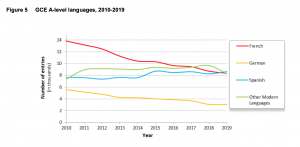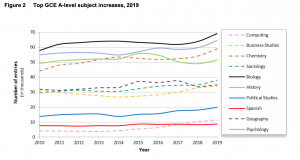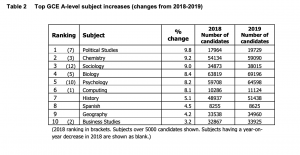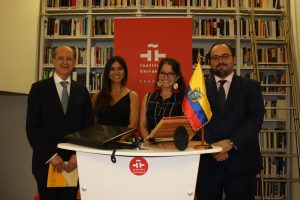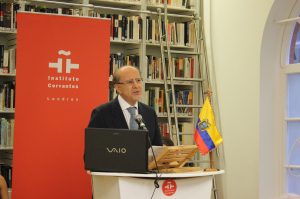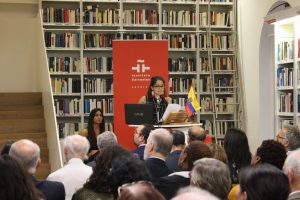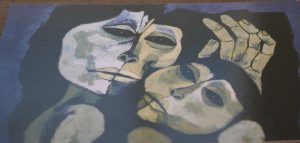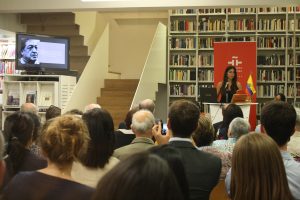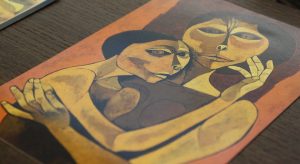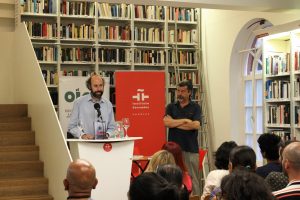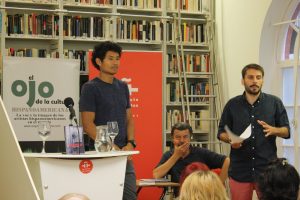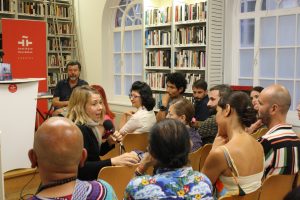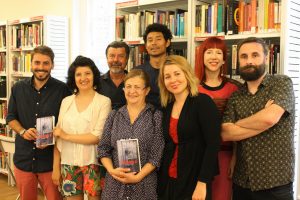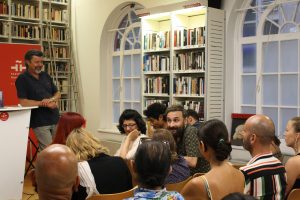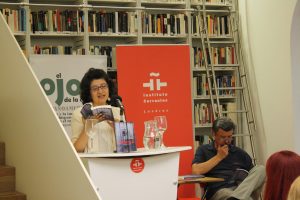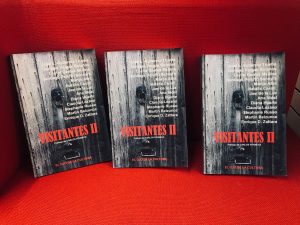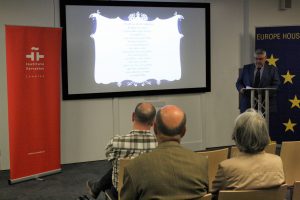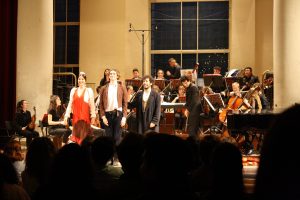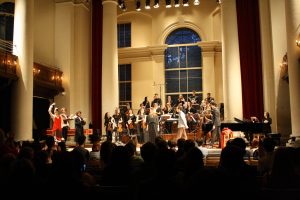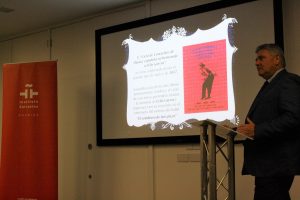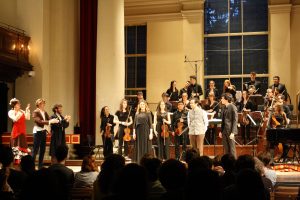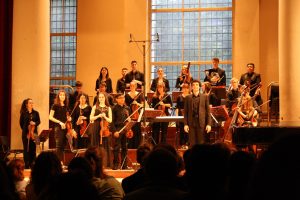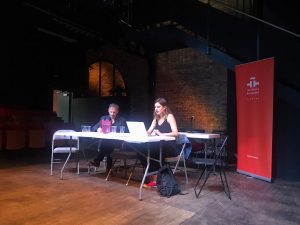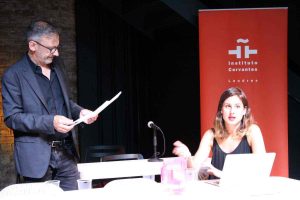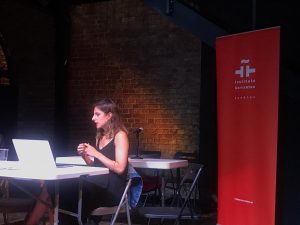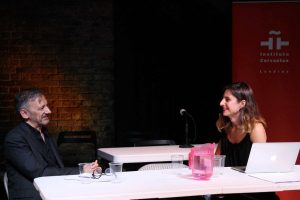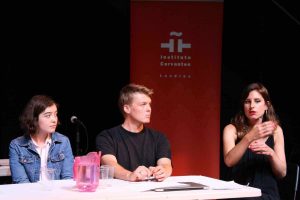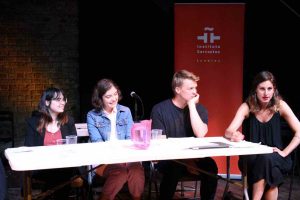Bartolomé Bermejo, the great painter of the Crown of Aragon, seduces in London

The curatorial fellow of the National Gallery exhibition “Bartolomé Bermejo. Master of the Spanish Renaissance”, Akemi Herráez Vossbrink, gave a lecture on the life and work of this Spanish painter, organized by Instituto Cervantes in London in collaboration with the National Gallery.
Bartolomé Bermejo (h. 1440-h. 1501), a Spanish Master from Cordoba who worked in the territories of the Crown of Aragon, was one of the most fascinating personalities of the artistic panorama of the second half of the fifteenth century. He led an itinerant lifestyle, working in Valencia, Tous, Daroca, Zaragoza and, finally, Barcelona.
“It is incredible to have seven of his works here. This will probably not happen again in a long time,” said Herráez, in relation to the exhibition in the British capital, which will remain open until September 29. In addition, the director of Instituto Cervantes in London, Ignacio Peyró, highlighted “the exceptional thing about having, in such a short space of time, Murillo, Sorolla and Bermejo, three Spanish painters, in a world-class institution such as the National Gallery”.
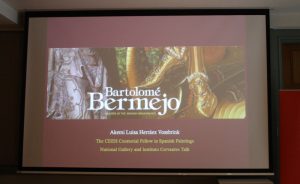
Herráez’s lecture focused on the seven paintings in the exhibition, analysing their context and considering them within the development of Bermejo’s artistic career. Among them, the “Saint Michael”, “The Virign of Montserrat” and the “Pietà Desplà” received special attention comparing their patrons, craftsmanship, location and historical context.
“Saint Michael” is Bermejo’s only work on British soil, while the rest of the pieces in the exhibition travelled to London for the first time for this occasion. An exceptional occurrence, other paintings such as “The Virgin of Montserrat” and “Pietà Desplà” had not previously been moved for almost 500 years from their respective cathedrals of Acqui Terme and Barcelona.
A few years ago, the National Gallery restored the painting “Saint Michael triumphant over the Devil with the Donor Antoni Joan.” This restoration highlighted Bermejo’s masterful technique, mixing features of Flemish and Spanish painting, in a painting that has no equal among his Spanish contemporaries.
The exhibition takes place in London, after two major Bermejo exhibitions were held recently at the Prado Museum in Madrid and at the National Museum of Art of Catalonia (MNAC) in Barcelona, both showing around 48 pieces from different periods of Bermejo’s career, including works by the master, his contemporaries, copies and other comparative objects.

Warm welcome
Bermejo’s exhibition at the National Gallery, directed by Gabriele Finaldi and with Letizia Treves as the main curator, has been well received by the British public over the course of the summer. Many of the visitors recognized the “Saint Michael”, which they had seen for years in the National Gallery, but now they can admire it in its restored form.
“Previously, many details of the plants had been lost, it was quite brown and, most noticeably, the gold above had been practically lost. Before the exhibitions, a conservator, an external gilder and the scientific team here restored it, and thanks to that, we were able to start the project. A technical essay was written on the investigations that were done at the time and published in the London exhibition catalogue dedicated exclusively to Saint Michael and its context,” added Herráez.
Herráez also believes that the public is fascinated by Bermejo’s attention to detail, especially by the animals and plants. “It’s something that the public loves, as well as the comical aspect of the demons.”
El español ya es la lengua extranjera más solicitada en los exámenes preuniversitarios británicos
El número de alumnos que se examinó de lengua española en las pruebas preuniversitarias del Reino Unido superó este año por primera vez a los de francés, según datos divulgados este jueves por Consejo Único de Calificaciones británico (JCQ, en inglés).
En total, 8.625 alumnos se matricularon de español en los exámenes conocidos como A-Levels, un 4,3 % más que el año pasado, mientras que los de francés descendieron un 3,8 %, hasta 8.355, y los de alemán cayeron también, un 0,7 %, hasta 3.033 alumnos.
Desde 2011, los test preuniversitarios de español en el Reino Unido han aumentado un 15 %, mientras que los de francés se han desplomado un 36 %.
El director del Instituto Cervantes de Londres, Ignacio Peyró, explicó que en los últimos años ha habido preocupación por los estudiantes que toman idiomas extranjeros en GCSE y A-level.
«Para nosotros, por supuesto, es muy positivo que el español esté creciendo y creo que en un país global como el Reino Unido, hay una percepción creciente de que el mundo de habla hispana se está volviendo más importante en términos de demografía, economía, comercio, cultura, etc», señaló Peyró.
«¿Quién hubiera pensado que hace 20 ó 30 años que esto iba a suceder?», añadió Peyró, señalando como en aquel momento, otros idiomas como el francés se enseñaban con más frecuencia.
«El español estaba en un lugar muy diferente en ese momento», recalcó Peyro, quien añadió que era «bueno estudiar cualquier idioma extranjero, mejor que ninguno».
«Espero que todos los idiomas extranjeros pronto vuelvan a aumentar en Reino Unido», agregó.
Más información: nota de prensa de JCQ ,Diario ABC, La Vanguardia
Ecuador y España reivindican en Londres a Guayasamín como uno de los grandes artistas y testigos del siglo XX
El Instituto Cervantes celebra el centenario del artista con una conferencia de Daniela Galán y Estefanía Solórzano en el marco del Día Nacional del Ecuador
La Embajada del Ecuador y el Instituto Cervantes celebran en Londres los 100 años del natalicio del gran pintor y artista ecuatoriano Oswaldo Guayasamín, con una conferencia de la artista e historiadora de arte de la Universidad Goldsmiths, Daniela Galan, y la antropóloga de danza, bailarina y actriz, Estefania Solórzano.
«Como embajador del Ecuador en el Reino Unido, es un honor conmemorar el jueves 8 de este mes, en el Instituto Cervantes de Londres, el centenario del nacimiento del artista Oswaldo Guayasamín, un gigante del Ecuador y de América, cuya obra es conocida alrededor del mundo. Sus creaciones plásticas conmueven por su fuerza estética y el mensaje perdurable de las obras eternas”, explica Jaime Alberto Marchán Romero, Embajador del Ecuador ante el Reino Unido.
Marchán Romero destaca que el maestro ecuatoriano dominó todas las expresiones de su arte: lienzo, composición mural, escultura, grabados, entre otras, y que, en el ámbito intelectual, desempeñó un papel decisivo en la lucha por sus ideales de justicia social. “A través de su pincel, habló por los oprimidos del mundo. Su grito fue inmenso y aún resuena, iracundo y altivo, en museos, ágoras, muros y plazas, pero, sobre todo, en el corazón de los hombres”, añade.
El Embajador considera que este evento en el Instituto Cervantes en la capital inglesa tiene una significación especial, pues es una oportunidad para dar a conocer mejor la obra del gran artista ecuatoriano en este país cosmopolita y para renovar también con el Instituto Cervantes “los profundos lazos que unen a los países iberoamericanos mediante la lengua, la cultura y el arte, a través de las cuales nos hemos enriquecido mutuamente”.
“Guayasamín es un artista que parece resumir la grandeza y las contradicciones de Hispanoamérica. Más allá de su potencia plástica, tan característica y tan ligada a las tradiciones del subcontinente, todos los temas hispanoamericanos están en él. Y digo hispanoamericanos porque pocos artistas han hecho tan bien de puente entre América y España. Para nosotros es una alegría abrir las puertas a Guayasamín y al Ecuador en su día nacional”, señala el director del Instituto Cervantes de Londres, Ignacio Peyró.
En Ecuador, cuando Estefania Solórzano inició sus estudios de teatro, empezó a ir mucho a los museos y además se acercó a la pintura, la danza y la literatura ecuatoriana. Fue ahí cuando también redescubrió la obra de Guayasamín y empezó a frecuentar el museo ‘La capilla del hombre’, en Quito, construido por el artista en homenaje al ser humano.
La expresión más íntima del ser humano
Guayasamín estuvo siempre rodeado de muchos amigos artistas (pintores, músicos, escritores, etc.) y Solórzano se interesó por conocer la historia de ese círculo. “Siempre me llamó la atención de Guayasamín el enfoque en los ojos, las manos y el rostro. Lo veo como la manera en la que uno llega a conocer a otra persona a través de la mirada. Guayasamín nos propone la expresión más íntima del ser humano en los ojos y en las manos, y es ahí donde están el terror, el amor, la ternura y la poesía”, explica.
Solórzano comenzó su Máster en Antropología de la Danza hace dos años, en un itinerario que la llevó a Noruega, Francia, Hungría y finalmente a Reino Unido, el pasado mes de enero. En la actualidad, desarrolla un proyecto basado en la memoria y el olvido, para el que se inspiró en una de las obras de Guayasamín: “Mientras viva siempre, te recuerdo”, que pertenece a la serie ‘La edad de la ternura’.
“La piel afuera, la piel adentro”
Solórzano se identifica con Guayasamín y su idea de “La piel afuera, la piel adentro”. En el primero, Guayasamín hace referencia a su trabajo artístico en el tiempo que le ha tocado vivir; mientras que, en el segundo término, engloba todas las experiencias de niño y lo que vivió con su familia, unos hechos que le conmovieron toda su vida.
Guayasamín describe que pintó ‘La edad de la ira’ como si gritara desesperadamente, sumándose a todos aquellos gritos que expresan la humillación y la angustia de los hechos de horror vividos por la Humanidad en el siglo XX.
En el caso de la historiadora Daniela Galan, su charla gira sobre la importancia del artista en el contexto de la historia del arte latinoamericano y su impacto en la construcción de la escena artística mundial. La ira será el punto de partida para examinar cómo Guayasamín y otros artistas abordan lo indescriptible, situaciones de dolor, trauma y violencia, sin caer en el sensacionalismo.
“En los cuadros de Guayasamín se puede ver no solamente el dolor de las víctimas, si no la frustración de vivir en ciertos momentos históricos y de haber vivido tanto dolor, como el Holocausto, la Guerra Civil española o las bombas de Hiroshima y Nagasaki”, explica Galan, para quien Guayasamín es indispensable en la historia del arte latinoamericano para hacer un grito a los derechos de los indígenas, con su mezcla de indígena y mestizo.
Ecuador and Spain introduce Guayasamín in London as one of the great artists and witnesses of the 20th century
The Embassy of Ecuador and Instituto Cervantes celebrate, in London, the 100th anniversary of the birth of the great Ecuadorian painter and artist Oswaldo Guayasamín, with a conference by Goldsmith University art historian and artist Daniela Galán and the dance anthropologist, dancer and actress Estefanía Solórzano.
«As Ambassador of Ecuador in the United Kingdom, it is an honor to commemorate this month, at Instituto Cervantes in London, the centenary of the birth of the artist Oswaldo Guayasamin, a giant from Ecuador and America, whose work is known around the world, his plastic creations are moved by his aesthetic strength and the enduring message of eternal works,” explains Jaime Alberto Marchán Romero, Ambassador of Ecuador to the United Kingdom.
Marchán Romero emphasizes that the Ecuadorian master dominated all the expressions of art: canvas, mural composition, sculpture and prints. Romero added that, in the intellectual field, Guayasamín played a decisive role in the struggle for his ideals of social justice. “Through his brush, he spoke for the oppressed of the world. His cry was immense and still resonates, angry and haughty, in museums, walls and squares, but, above all, in the hearts of men,” he adds.
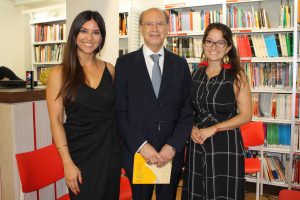
The Ambassador believes that this event at Instituto Cervantes has a special significance, as it is an opportunity to make the work of the great Ecuadorian artist better known in this cosmopolitan country. It also renews in Instituto Cervantes, “the deep ties that unite Latin American countries through language, culture and art, through which we have enriched each other.”
“Guayasamín is an artist who seems to summarize the greatness and contradictions of Latin America. Beyond its plastic power, so characteristic and so linked to the traditions of the subcontinent, all Latin American themes are in it. And I say Hispanic Americans because few artists have made such a good bridge between America and Spain. For us it is a joy to open the doors to Guayasamín and Ecuador on their national day, ”says the director of the Cervantes Institute in London, Ignacio Peyró.
In Ecuador, when Estefanía Solórzano began her theatre studies, she began to go to museums a lot and also approached Ecuadorian painting, dance and literature. It was at that time when she also rediscovered the work of Guayasamín and began to frequent the museum ‘La chapel of man’, in Quito, built by the artist in homage to the human being.
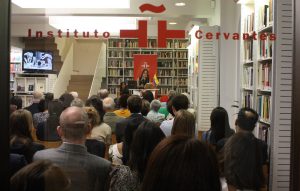
The most intimate expression of the human being
Guayasamín was always surrounded by many artist friends (painters, musicians, writers, etc.) and Solórzano was interested in knowing the history of that circle. “The focus on the eyes, hands and face always struck me. I see it as the way in which one gets to know another person through the eyes. Guayasamin offers us the most intimate expression of the human being in the eyes and hands, and that is where terror, love, tenderness and poetry are,” she explains.
Solórzano began her MA in Dance Anthropology two years ago, on an itinerary that took her to Norway, France, Hungary and finally to the United Kingdom last January. Currently, she develops a project based on memory and oblivion, for which she was inspired by one of Guayasamín’s works: “As long as I live forever, I remember you”, which belongs to the series ‘The age of tenderness’.
«The skin outside, the skin inside»
Solórzano identifies with Guayasamín and his idea of «The skin outside, the skin inside». In the first one, Guayasamín refers to his artistic work in the time he has lived; while, in the second term, he encompasses all the experiences of a child and what he lived with his family, facts that moved him all his life.
Guayasamín describes that he painted ‘The Age of Wrath’ as if he were screaming desperately, adding to all those screams that express the humiliation and anguish of the horror events experienced by Humanity in the twentieth century.
The construction of a world art scene
In the case of historian Daniela Galán, her talk revolves around the importance of the artist in the context of the history of Latin American art and its impact on the construction of the world art scene. Anger will be the starting point to examine how Guayasamín and other artists approach the indescribable, situations of pain, trauma and violence, without falling into sensationalism.
«In the paintings of Guayasamín you can see not only the pain of the victims, but also the frustration of living in certain historical moments and having lived so much pain, such as the Holocaust, the Spanish Civil War or the bombs of Hiroshima and Nagasaki», explains Galan, for whom Guayasamín is indispensable in the history of Latin American art. He also drew attention to the rights of the indigenous, with his mixture of indigenous and mestizo.
Londres, puerta a la literatura en lengua española
El Instituto Cervantes acoge la presentación de un libro de doce autores españoles e hispanoamericanos que viven en la capital británica.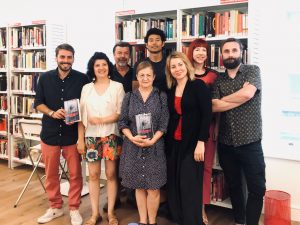
Doce autores de lengua española procedentes de Argentina, Bolivia, Uruguay, México, Nicaragua, España y Ecuador y residentes en Londres hablarán hoy a las 7pm en la sede londinense del Instituto Cervantes sobre su nuevo libro: Visitantes II, fruto de los talleres de escritura creativa de El Ojo de la Cultura Hispanoamericana.
«Londres es una capital literaria y de la creatividad en lengua española por la cantidad de hispanohablantes que crean en ella”, explica Ignacio Peyró, director del Instituto Cervantes de Londres, quien destaca la vocación iberoamericana del centro.
Los doce autores españoles y latinoamericanos son: José Luis Gutierrez Trueba, Denisse Vargas Bolaños, Lester Gómez Medina, Santiago Peluffo Soneyra, Marijo Alba, Natalia Casali, Jael de la Luz, Ana Vidal, Diana Huarte, Claudia Lozano, Stephanie Russo y Martín Belzunce, coordinados por el escritor argentino Enrique D. Zattara.
Todos ellos hablarán sobre su trabajo y su experiencia en un taller de escritura que comenzó Zattara en septiembre de 2015 y por el que han pasado una treintena de escritores presencialmente y de manera virtual.
Precisamente, el Ojo de la Cultura Hispanoamericana, ZTR Radio y el Instituto Cervantes de Londres colaboran juntos desde octubre de 2017 en el ciclo “Autores en busca de lector”, destinado a difundir entre los lectores británicos la obra de escritores hispanoamericanos aún poco conocidos en este país.
Talleres de escritura para mejorar los relatos
Zattara destaca el papel de los talleres de escritura para ayudar a los escritores, a través del desarrollo de técnicas y recursos para mejorar el relato y lo que funciona o no. Además, explica cómo desmontan los cuentos y los recursos utilizados por escritores como el argentino Jorge Luis Borges.
“Decía Ricardo Piglia que los primeros escritos eran particularmente interesantes pues en ellos quedaba retratado la búsqueda de un estilo y la apuesta por una forma bajo la cual pensar la literatura’ – afirma sobre este libro el escritor Carlos Fonseca, autor del prólogo del mismo. ‘La belleza de un libro como éste recae, entonces, en que ese estilo y esa forma se piensan colectivamente”.
En el caso del escritor Lester Gómez Medina, costarricense de origen nicaragüense, se incluyen cuatro de sus cuentos cortos, en los que recoge sus experiencias de la infancia y cómo repercuten en la vida adulta. Gómez Medina destaca el papel de los talleres como hablante de la lengua castellana en Londres, así como para consolidar la escritura y crear un vínculo con otros escritores a los que ya tilda de amigos.
Por su parte, Diana Huarte, cantante argentina de música electrónica del grupo Shh, llegó al taller de escritura hace dos años tras un problema de salud y con ganas poder desarrollar su creatividad. Además, se suma al proyecto el cántabro José Luis Gutiérrez Trueba con sus relatos, para los que se inspira en ideas que toma de la calle, noticias que va leyendo a lo largo del día, reflexiones de la época actual y el impacto de las redes sociales y el Brexit.
Un proyecto para difundir a creadores hispanoparlantes
El Ojo de la Cultura Hispanoamerica en Londres es un proyecto cultural multimedia que se propone comunicar y difundir a los creadores artísticos hispanohablantes en todo el mundo. Desarrollan sus propósitos a través de diversos formatos, tales como radio cultura, a través de los podcast de ZTR radio en el que realizan una programación exclusivamente cultural en castellano e inglés, que se emite además en directo en colaboración con ExraRadio1 de Londres.
Además, hacen ciclos, lecturas y conferencias para la difusión y conocimiento de artistas hispanoamericanos, en castellano e inglés, propios o en colaboración con instituciones como el Instituto Cervantes, diversas Embajadas latinoamericanas, y alguna universidades, y también organizan espectáculos abiertos al público donde se realiza un encuentro de disciplinas artísticas tales como la poesìa, la música y la danza, el teatro, el cine, etc.
London opens the door to literature in Spanish language
Instituto Cervantes in London welcomes the presentation of a book celebrating twelve Spanish and Latin American authors living in the British capital.
Twelve Spanish-language authors from Argentina, Bolivia, Uruguay, Mexico, Nicaragua, Spain and Ecuador will speak today at 7pm at the London headquarters of Instituto Cervantes. All the writers now live and work in London, and their new book, Visitors II was written after attending the creative writing workshop, El Ojo de la Cultura Hispanoamericana (The Eye of Hispanic American Culture).
«London is a literary and creativity capital in Spanish because of the number of Spanish speakers who create in it,» says Ignacio Peyró, director of the Cervantes Institute in London, who highlights the Latin American vocation of the centre.
The twelve Spanish and Latin American authors are: José Luis Gutiérrez Trueba, Denisse Vargas Bolaños, Lester Gómez Medina, Santiago Peluffo Soneyra, Marijo Alba, Natalia Casali, Jael de la Luz, Ana Vidal, Diana Huarte, Claudia Lozano, Stephanie Russo and Martín Belzunce, coordinated by the Argentine writer Enrique D. Zattara.
All of them will talk about their work and their experience after attending the writing workshop that Zattara started in September 2015 and through which thirty writers have attended both face to face or online.
The Eye of Hispanic American Culture, ZTR Radio and Instituto Cervantes in London have been collaborating together since October 2017 in the “Authors in search of reader” cycle, aimed at spreading the work of Spanish-American writers still little known in this country among the British readers.
Writing workshops to improve stories
Zattara highlights the role of writing workshops to help writers, through the development of techniques and resources to improve the story and going through what will work or not. In addition, he explains how they disassemble the stories and resources used by writers such as the Argentine Jorge Luis Borges.
“Ricardo Piglia said that the first writings were particularly interesting because they were portrayed in the search for a style and the commitment to a way in which to think about literature”, says writer Carlos Fonseca, author of the prologue in this book. «The beauty of a book like this falls, then, on that style and form are thought collectively.»
In the case of the writer Lester Gómez Medina, a Costa Rican of Nicaraguan origin, four of his short stories are included. In them, he gathers his childhood experiences and how they impact on adult life. Gómez Medina highlights the role of the workshops as a speaker of the Spanish language in London, as well as to consolidate the writing and create a link with other writers to whom he already calls friends.
On the other hand, Diana Huarte, Argentine singer of electronic music of the group called Shh, arrived at the writing workshop two years ago after a health problem and eager to develop her creativity. In addition, the Cantabrian José Luis Gutiérrez Trueba joins the project with his stories, inspired by ideas that he takes from the street, news he is reading throughout the day, reflections of the current era and the impact of social networks and Brexit.
A project to spread to Spanish-speaking creators
The Eye of Hispanic American Culture in London is a multimedia cultural project that aims to communicate and disseminate with Spanish-speaking artistic creators worldwide. They develop their motives through various formats, such as radio culture, through ZTR radio podcasts in which they carry out exclusively cultural programming in Spanish and English, which is also broadcast live in collaboration with ExraRadio1 of London.
In addition, they make cycles, readings and conferences for the dissemination and knowledge of Hispanic-American artists, in Spanish and English. These projects are both lone-ventures as well as in collaboration with institutions such as the Cervantes Institute, various Latin American Embassies, and some universities. They also organise public shows where they stage encounters of artistic disciplines such as poetry, music and dance, theater, cinema for the audience.
La historia oculta de ‘El Sombrero de Tres Picos’ de Manuel de Falla, al descubierto en Londres
A punto de cumplirse el centenario del estreno del ballet ‘El sombrero de tres picos’ (julio de 1919), el escritor, músico y docente Antonio Hernández Moreno presentó las investigaciones, realizadas en las dos últimas décadas, en una conferencia organizada por el Instituto Cervantes de Londres, que revelan que casi un tercio de la partitura de El sombrero de tres picos de Manuel de Falla fue compuesta y orquestada por los compositores Maurice Ravel y Ottorino Respighi.
Hernández Moreno encontró en la Houghton Library (Universidad de Harvard) una desconocida partitura manuscrita de la música completa del ballet en versión para piano bajo el título ‘Le Chapeau tricorne’. La investigación demuestra, una vez analizadas las características caligráficas y las modificaciones que sufrió la obra original que Falla compuso bajo el título de ‘El Corregidor y la molinera’, que Ravel y Respighi arreglaron, terminaron y orquestaron la obra que daría lugar a la partitura definitiva del ballet ‘El sombrero de tres picos.’
En junio de 1916, el empresario ruso Sergei Diaghilev (en agradecimiento a las ayudas recibidas por Alfonso XIII en la liberación de Nijinsky de un campo de concentración al inicio de la Guerra Mundial) acuerda en Madrid con el dramaturgo Gregorio Martínez Sierra adaptar la novela de Pedro Antonio de Alarcón ‘El sombrero de tres picos’, para la creación de un ballet español que interpretarían los Ballets Russes. Manuel de Falla fue el compositor elegido por Diaghilev.
Después de un primer intento de estrenar la obra en Roma a principios de 1917 con ‘bailaores’ españoles, y tras un grave desencuentro con Nijinsky – ya liberado y en España– para que la estrenara junto a Pastora Imperio, Diaghilev contrata finalmente al joven y brillante bailarín español Félix García, para enseñar los ritmos españoles a los miembros de la compañía y protagonizar además dicho ballet. Félix García, además de músico, era un ‘bolero’ (nombre que recibía un bailarín experto en bailes del país), y no un ‘bailaor’ flamenco de origen andaluz como se creía.
Por entonces, la compañía de los Ballets Russes se encontraba estancada en España a causa de la Guerra Mundial, así que tras actuar en Lisboa y realizar un gira por varias ciudades de España, y casi disolverse, Diaghilev consigue liberarla del bloqueo gracias una vez más a las gestiones diplomáticas de Alfonso XIII, lo que le permite a Diaghilev y su compañía viajar finalmente a Londres en agosto de 1918.
Tras una larga temporada de actuaciones en el Coliseum Theatre, la compañía pasa al Alhambra Theatre, donde Diaghilev ya tiene previsto estrenar ‘El Corregidor y la molinera’ junto a otros ballets de carácter español. Pero nuevos contratiempos y retrasos, entre ellos la terminación de la partitura definitiva del ballet por parte de Falla, provocó que Diaghilev contratara en secreto a los compositores Ravel y Respighi para que la terminaran. La sustitución de Félix y Sokolova en los papeles principales, y el ingreso del bailarín español en un sanatorio mental no impidió que el ballet, ya con el nuevo título de “El sombrero de tres picos” se estrenara ‘in extremis’ el último día de actuación. Picasso diseñó los decorados y el vestuario, realizando un dibujo a lápiz de Félix y Sokolova durante un ensayo, única imagen que se conserva hasta ahora del bailarín español.
Hernández Moreno que establece también un paralelismo entre lo sucedido a Félix García y el destino final del legendario bailarín ruso Vaslav Nijinsky. La investigación concluye además que el conocido ‘Bolero’ de Ravel fue motivado y dedicado en secreto al propio Félix.
Los resultados de esta investigación han sido publicados de forma novelada en el libro ‘Treinta castañuelas para Londres’ que saldrá a la venta en las próximas semanas.
The hidden story of ‘The three-cornered hat’ by Spanish composer Manuel de Falla
On the occasion today of the centenary of the premiere of the ballet ‘The Three-cornered Hat’ (22nd July 1919), the research, carried out in the last two decades by the Spanish writer, musician and teacher Antonio Hernández Moreno, reveals that almost a third of the ballet score by Manuel de Falla was composed and orchestrated by composers Maurice Ravel and Ottorino Respighi.
The researcher made this information public at a lecture hosted by the Instituto Cervantes in London, hosted at the Europe House. The writer found in the Houghton Library (Harvard University) an unknown manuscript score of the ballet complete music on piano version under the title ‘Le Chapeau tricorne’. The study demonstrates, once analysed the calligraphic features and modifications made on the previous work composed by Falla under the title of ‘The Governor and the miller’s wife’, that Ravel and Respighi arranged, finished and orchestrated the work that would become the final score of the ballet ‘The Three-cornered hat.’
In June 1916, the Russian impresario Sergei Diaghilev (in gratitude for the aid received by King Alfonso XIII in the release of Nijinsky from a concentration camp at the beginning of the World War) agreed in Madrid with the playwright Gregorio Martínez Sierra to adapt the famous novel by Pedro Antonio de Alarcón, into a plot for a Spanish ballet to be premiered by the Ballets Russes. Manuel de Falla was the chosen composer by Diaghilev.
After a first failure attempt to premiere the ballet in Rome at the beginning of 1917 with Spanish ‘bailaores’, and after a serious disagreement with Nijinsky – already released and in Spain- to be represented with Pastora Imperio; Diaghilev finally hires the young and brilliant Spanish dancer Félix García, to teach the Spanish rhythms to the members of the company and also play the main role of the ballet. Felix Garcia, was not only a musician but also a very gifted ‘bolero’ or ‘bolerist’ (name given to a virtuoso dancer specialised in Spanish national dances), and not an Andalusian ‘bailaor’, as it was believed until now.
At that time, the Diaghilev’s Ballets Russes was stuck in Spain because of the World War, so after a rugged performances in Lisbon and a tour through some Spanish cities, and almost become dissolved, Diaghilev managed to release it from the blockade thanks once more to the diplomatic efforts made by King Alfonso XIII, which finally allow Diaghilev and his company to travel to London in August 1918.
After a long season at the Coliseum Theater in London, the company moves to the Alhambra Theater, where Diaghilev has already planned to premiere ‘The Governor the miller’s wife’ along with another Spanish character ballets. But new setbacks and delays, including the never finishing of the final ballet score by Falla, caused Diaghilev to secretly hire the composers Ravel and Respighi services to finish it. The replacement of Felix and Sokolova replacement in their main roles, and the confine of the Spanish dancer in a mental hospital did not prevent the ballet, now retitled ‘The Three-cornered Hat’ was premiered ‘in extremis’ on the last day of the season performance. Picasso designed sets and costumes, making a pencil drawing of Felix and Sokolova during a rehearsal, the only surviving image of the Spanish dancer.
Hernandez-Moreno establishes as well a parallel between what happened to Felix Garcia and the final destiny of the legendary Russian dancer Vaslav Nijinsky. The research also concludes that the orchestral masterwork ‘Bolero’ by Ravel was inspired, motivated and secretly dedicated to Felix. The results of this study have been published in a novelized way in the book ‘Thirty castanets for London’ that will be coming soon in weeks.
On the other hand Hernandez Moreno has promoted and managing a Spanish music and dance festival for three years in homage to Félix García, with the aim of honouring his memory and trying to erase the unfair nickname of ‘Felix the Mad’, maliciously or wrongful named for several decades.
The passage of Diaghilev’s Ballets Russes through Spain claimed two victims: Nijinsky, who lived the rest of his life among several mental sanatoriums in Switzerland; and Felix Garcia, who spent almost twenty years inmated and forgotten in a mental hospital in Epsom (England) until he died in 1941, where his rest remains in an abandoned cemetery.
The theatre of Ramírez-Pantanella arrives in London thanks to Instituto Cervantes and Cervantes Theatre
The playwright, stage director and one of the scriptwriters of «Money Heist» Almudena Ramírez-Pantanella, will talk about her creation and will read extracts from her latest work, «Golpe de gracia», in an event that will take place on Saturday, July 20 at 4:00 pm at Cervantes Theatre in London.
«Collaborating with the Instituto Cervantes and the Cervantes Theatre is a joy and a great opportunity to publicise my work abroad. I hope that opportunities for the representation of my works can emerge here in the United Kingdom,» she explains.
Throughout her work, Ramírez-Pantanella reflects on contemporary subjects including South Korean philosopher and essayist Byung-Chul Han, the French philosopher and sociologist Jean Baudrillard and Italian writer, poet and film director Pier Paolo Pasolini.
«For us, it is important to support Spanish theatre in one of the world capitals of the theatre,» explains Ignacio Peyró, director of the Instituto Cervantes in London. «With our support of the talk and reading of Almudena Ramírez-Pantanella, we seek to show and give visibility to the talent of Spanish playwrights, as we have done in other cycles with the Cervantes Theatre and also in the cinema, with the screening of the Female Space films in the same theatre this spring «.
For her part, the associate director of the Cervantes Theatre, Paula Paz, recognizes that it is a pleasure to be able to receive Almudena again and open the doors of her theatre so she can share her experience at the residence of the Royal Court. «The Cervantes Theatre was born, among other things, with the aim of making known new Spanish dramaturgy and to serve as an international platform in London for our playwrights. This year at the Cervantes Theatre, ‘They take the floor’ and this Saturday we will be able to hear and learn first-hand the latest work of Almudena Rodríguez-Pantanella,» Paz adds.
At first, Ramírez-Pantanella explains that what interested her was the figure of the «influencer» and making a work in which, using her figures as protagonists, she could reach a young audience. For now, the theatre is where Ramírez-Pantanella feels more comfortable and where she finds more artistic freedom, since it offers her more possibilities to explore language, dialogues and images.
Ramírez-Pantanella has worked as a screenwriter in the celebrated series «Money Heist», an experience that she considers «important» in her career: «This is a series that has had worldwide success and being part of the team is a pride».
Residence at the Royal Court Theater
The playwright, who participates in a residency at the Royal Court Theater in London, gets the best out of this experience. «I have been immersed for three weeks in the English theatre, reading and watching theatre. I’m leaving with an infinite list of English authors, but also European ones, that I want to read», she emphasizes. Through meetings with different authors, directors, literary departments, development and production, the Spanish author has been able to discover some initiatives that are being carried out in the United Kingdom to support the theatre and specifically the dramatists, which she hails as, «very interesting to support public theatre.»
The playwright recognizes that she has had the good fortune to meet theatre writers she admires as Martin Crimp, and has also discovered «the inspiring personality» of the author Caryl Philipps. In addition, during the residency, she has worked with Sarah Maitland in the translation of the play ‘Golpe de Gracia’, which has given her many keys to rewriting the text, also along with Anthony Simpson Pike and Ellie Horne, who have helped her in the process of rewriting.
This summer, Ramírez-Pantanella will participate in a congress in Mérida on «Dialogues with the Greco-Latin Classics and the New Dramaturgies». In fact, she does not hide her desire that in the future he could write something for the Merida festival. In addition, in August she will finish the writing of a monologue that for now is entitled «Attacking the sun». And she is also in the pre-production phase of her first film, together with the production company Canacosmi Producciones. The film is already written, it is titled «The great machine» and they intend to start shooting it next summer.
El teatro femenino de Ramírez-Pantanella llega a Londres de la mano del Instituto Cervantes y el Cervantes Theatre
La dramaturga, directora de escena y parte del equipo de guión de “La casa de papel” , Almudena Ramírez-Pantanella, hablará de su creación y hará una lectura de extractos de su última obra, ‘Golpe de gracia’, en un evento que tendrá lugar el sábado 20 de julio a las 16:00 horas el Cervantes Theatre de Londres.
“Colaborar con el Instituto Cervantes y el Cervantes Theatre es una alegría y una ocasión magnífica para dar a conocer mi trabajo en el extranjero. Ojalá así puedan surgir oportunidades de representación de mis obras aquí en Reino Unido”, explica.
Ramírez-Pantanella desarrolla a lo largo de la obra una reflexión sobre el sujeto contemporáneo, a donde llega tras trabajar obras de, entre otros, el filósofo y ensayista surcoreano experto en estudios culturales Byung-Chul Han, el filósofo y sociólogo francés Jean Baudrillard y el escritor, poeta y director de cine italiano Pier Paolo Pasolini.
“Para nosotros es importante apoyar al teatro español en una de las capitales mundiales del teatro», explica Ignacio Peyró, director del Instituto Cervantes de Londres. «Con nuestro apoyo a la charla y lectura de Almudena Ramírez-Pantanella buscamos mostrar y dar visibilidad al talento de las dramaturgas españolas, tal y como hemos hecho en otro ciclos con el Cervantes Theatre y también en el cine, con la proyección de las películas de Espacio Femenino en el mismo teatro esta primavera”.
Por su parte, la directora asociada del Cervantes Theatre, Paula Paz, reconoce que es un placer poder recibir de nuevo a Almudena y abrirle las puertas de su teatro para que pueda compartir su experiencia en la residencia del Royal Court. “El Cervantes Theatre nació entre otras cosas con el objetivo de dar a conocer la nueva dramaturgia española y para que sirva de plataforma internacional en Londres para nuestros dramaturgos. Este año en el Cervantes Theatre ‘Ellas toman la palabra’ y este sábado podremos escuchar y conocer de primera mano el trabajo más reciente de Almudena Rodríguez-Pantanella”, añade Paz.
En un principio, Ramírez-Pantanella explica que lo que le interesaba era la figura del “influencer” y hacer una obra en la que, utilizando sus figuras como protagonistas, pudiera llegar a un público joven. Por ahora, en el teatro es donde Ramírez-Pantanella se siente más cómoda y donde encuentra más libertad artística, ya que le ofrece más posibilidades de explorar el lenguaje, los diálogos y las imágenes.
Ramírez-Pantanella ha trabajado como guionista en la celebrada serie “La casa de papel”, una experiencia que tilda de “importante” en su carrera: “Se trata de una serie que ha tenido un éxito mundial y poder formar parte del equipo es un orgullo”.
Residencia en el Royal Court Theatre
La dramaturga, que participa en una residencia en el Royal Court Theatre de Londres, se lleva lo mejor de esta experiencia. “He estado sumergida durante tres semanas en el teatro inglés, leyendo y viendo teatro. Me voy con una lista infinita de autores ingleses, pero también europeos, que quiero leer”, subraya. A través de encuentros con diferentes autores, directores, departamentos literarios, de desarrollo y de producción, la autora española ha podido descubrir algunas iniciativas que se están llevando a cabo en Reino Unido para apoyar el teatro y en concreto a los dramaturgos, unos proyectos que tilda de “interesantísimos para apoyar el teatro público”.
La dramaturga reconoce que ha tenido la suerte de conocer a escritores teatrales que admira como Martin Crimp, y ha descubierto asimismo “la personalidad inspiradora” del autor Caryl Philipps. Además, durante la residencia, ha trabajado con Sarah Maitland en la traducción de la obra ‘Golpe de Gracia’, lo que le ha dado muchas claves para la reescritura del texto, también junto con Anthony Simpson Pike y Ellie Horne, quienes le han ayudado en el proceso de reescritura.
Este verano, Ramírez-Pantanella participará en un congreso en Mérida sobre “Diálogos con los clásicos grecolatinos y las nuevas dramaturgias”. De hecho, no oculta su deseo de que en un futuro pueda escribir algo para el festival de Mérida. Además, en agosto va a terminar la escritura de un monólogo que por ahora se titula “Atacar el sol”. Y también está en fase de pre-producción de su primera película, junto con la productora Canacosmi Producciones. La película ya está escrita, se titula “La gran máquina” y tienen intención de empezar a rodarla el verano que viene.
